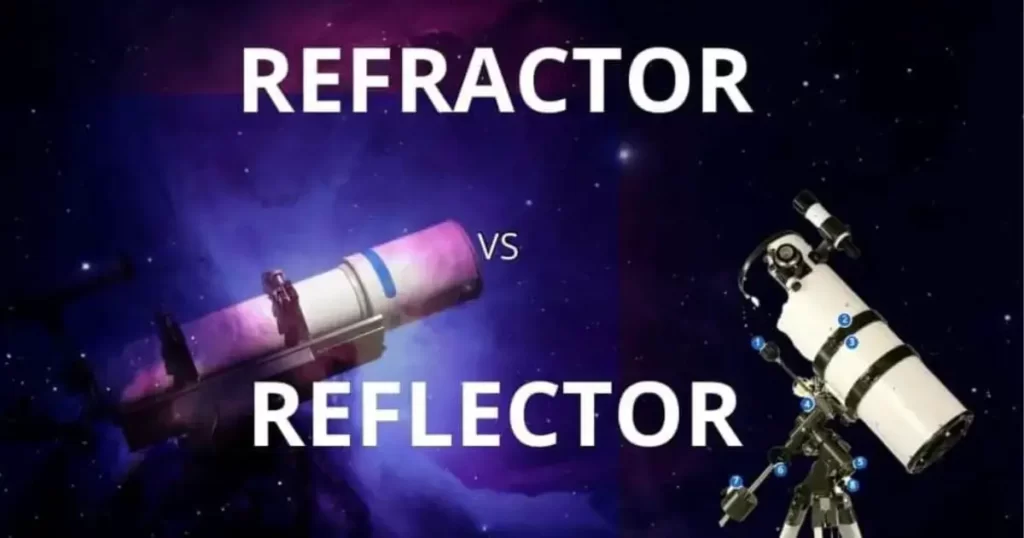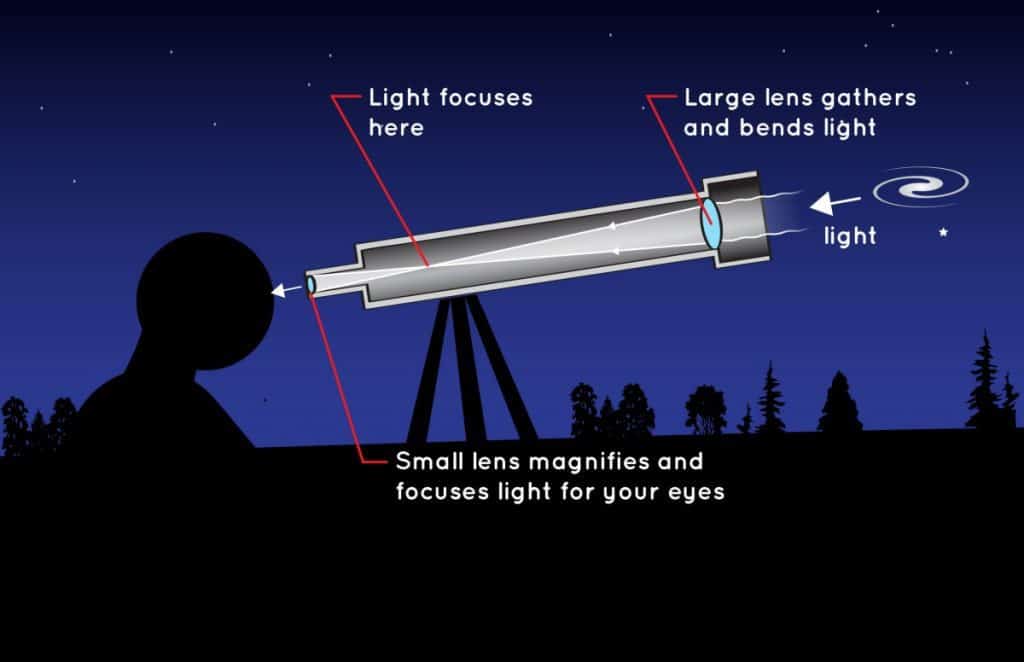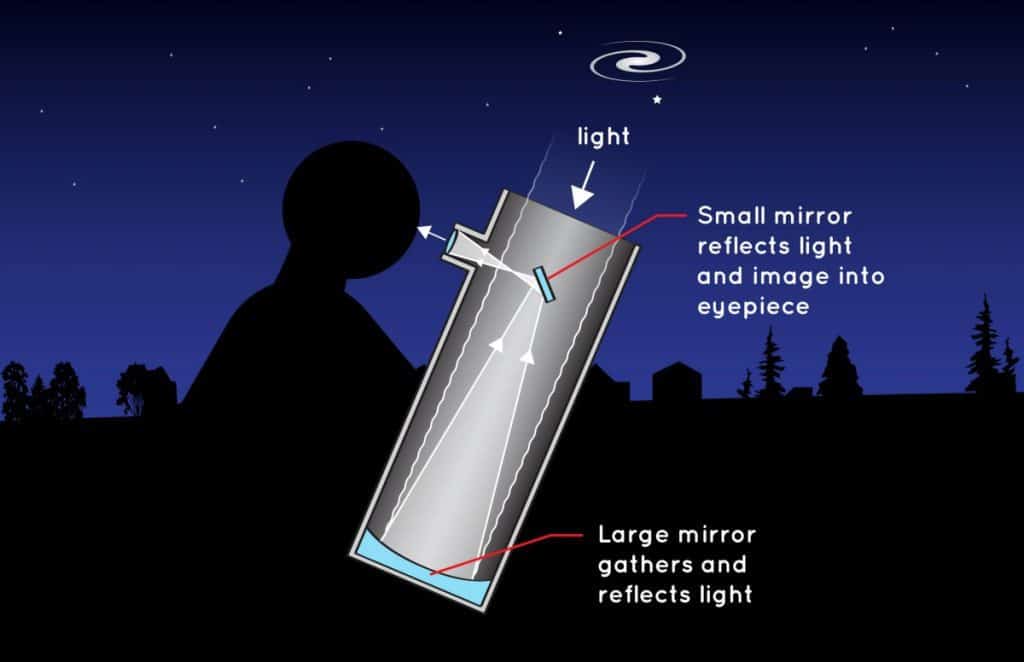Should you buy a reflector or a refractor telescope? Reflector telescopes use mirrors, refractor telescopes use lenses. Here are the refractor vs reflector pros and cons to help you make the right choice for you.

When I first searched for a telescope to observe the night sky, I knew nothing about how a refractor was any better or worse than a reflector. And I found myself asking the following question. Below is what I discovered.
Which telescope is better reflector or refractor?
Key takeaway: Choose a telescope based on what you want to use it for.
— Reflectors with larger apertures are better for viewing fainter objects like galaxies and nebulae
— Refractors provide brighter and sharper images of the Moon, planets, and stars
— Apochromatic refractors are well-suited to astrophotography
If you’re not sure what you want to use your telescope this article will help as it explores the differences and the pros and cons of reflector and refractor telescopes.
Obvious difference between reflector and refractor telescope
What quickly sets them apart: In the reflector the finderscope and seating for the eyepiece sit at the front (or the top), while in the refractor, these are at the back of the telescope tube (see images below).

Reflector or Refractor Telescope
What you choose will depend on your personal preferences. Do you want an instrument that’s compact and easy to transport? Do you want one that’s intermediate in price? And what you want to use the telescope for.
1. Light-gathering capacity
The aperture, which is the size of the telescope’s primary lens or mirror, determines the amount of light the telescope can gather and how much detail you can see.
Reflectors offer larger apertures for their size, which makes them better for observing faint and distant objects such as nebulas, star clusters, and galaxies.
‘Lens sag’, where the lens becomes distorted by its weight, is why in backyard astronomy you won’t find refractors with larger apertures.
2. Compactness
Refractors are more compact and less bulky than reflectors and therefore better for transporting. It’s also much easier to find a place to store them.
3. Image Quality
As a general rule – Refractors tend to provide sharper and clearer images with less distortion. Aberrations can affect image quality in both types.
Look for telescopes with compound lenses (different types of glass) to correct color aberrations. Doublets are less costly, but triplets, designed to eliminate this issue, cost more.
- Cheaper refractors are more prone to chromatic aberration, while reflectors are more prone to coma aberration
- Aberrations can be reduced or eliminated through the use of special lenses or mirrors
The presentation of aberrations will depend on the quality of the optics and design of the telescope in both types. Each can suffer optical aberrations. I wrote about ‘astigmatism’ a type of aberration in refractors, the causes, and the solutions.
4. Maintenance
Reflectors have mirrors that might need cleaning and aligning from time to time. Making sure to store the telescope properly will help avoid unneeded cleaning.
Reflectors need collimating more than refractors. I wrote about this in How to Collimate a Dobsonian.
The bigger the objective in the reflectors, the more regular the need for collimation. In cases of larger reflectors, this could be every time you move it to a new location. But with the right tools and practice, it will only take you 10 minutes or so.
Refractors require less maintenance because they do not have mirrors that need collimation.
5. use
According to Terence Dickinson, author of astronomy books, reflectors 4–8″ can perform well for viewing the Moon, planets, and other bright objects in the night sky. Whereas the larger aperture ones, reflectors 6″ upward, are a great choice if you’re wanting to concentrate on deep-sky objects such as the Messier catalog that include star clusters, nebulas, and galaxies.
Refractors are used in terrestrial observations as well as for astronomy. Reflectors on the other hand are not useful for this dual purpose.
Apochromatic refractors can be used for deep-sky observing, but may not provide as much contrast or detail as larger reflector telescopes. Apochromatic refractors, as said above, are popular for astrophotography.
6. Budget
The cost of the telescope is an important factor to consider. Refractors tend to be more expensive than reflectors of the same size due to the cost of the lenses.
The refractor telescope Design
Refractors are dioptric, meaning they bend or refract light.
They have a lens at the front. The eyepiece sits at the rear. They have a long, closed tube in which the light must travel in a straight path through to the eyepiece. The larger the lens the longer the tube needed. Hence, refractors tend to be small.

The Reflector telescope design
Reflectors are catoptric, meaning they reflect light. One or more curved mirrors are used and make them free from chromatic aberrations.

Most reflecting telescopes have a smaller secondary mirror. They have an eyepiece at the front and a tube that is open. Mirrors (vs lenses) mean the tube can be shorter relative to the aperture size.
Newtonian reflector Vs Refractor telescope Pros Cons
Refracting Telescope
- Uses lenses to bend and focus light
- Less bulky to transport
- Also suitable for land viewing
- Great for viewing bright, easy-to-find objects
- Less collimation needed to maintain good focus
Reflecting Telescope
- Uses mirrors to reflect and focus light
- Allows for larger apertures for viewing faint, deep-sky objects
- For the same size, less expensive than refracting telescopes
Pros of refractors:
- Image quality: In some respects, a refractor telescope is better than a reflector. With the same aperture size, they give brighter and higher-resolution images.
- Dual use: They are suitable for viewing the planets and the moon. But also double for terrestrial viewing.
- Portability: They are better for traveling. Being lightweight refractors are an ideal choice for travelers, who want something portable, and for children.
Cons of refractors:
- Cheaper refractors can suffer from chromatic aberrations, which present as a colored fringe around the image, like a rainbow.
- Some suffer from astigmatism, which is a minor aberration as I explain in my article about its causes and solutions.
- Aperture size-wise, they are limited by the effects of lens sag the larger they are.
Pros of reflectors:
- Mirror-based design: Reflector telescopes use mirrors instead of lenses to gather and focus light. This allows for larger apertures.
- Good for deep-sky observing: The design of reflector telescopes makes them well-suited for observing faint and distant objects such as galaxies and nebulae. Their large apertures provide a wider field of view than other types of telescopes.
- Low chromatic aberration: Because reflector telescopes do not use lenses, they are not subject to chromatic aberration – the distortion of color that can occur when using refracting telescopes.
- Less expensive: For example: Dobsonian reflectors are popular beginner telescopes because they offer more bang for the buck.
Cons of reflectors:
- Reflectors with spherical mirrors can suffer from spherical aberrations, which result in a blurry image. A parabolic mirror can introduce minor aberrations, like coma, producing stars that look comet-shaped.
Video: Key differences between reflectors and Refractors: A Beginners Guide
This video explains…
FAQs
Which telescope is better for viewing deep-sky objects
Generally, larger reflectors are better suited for viewing deep sky objects, such as galaxies and other Messier objects.
Reflectors or Refractors: Which is More Affordable for Beginner Astronomers?
Price-wise you can get a small refractor or a reflector telescope for under 200 but pay several hundred more for better quality models in both.
Sources
NASA On Telescopes | Space Place |
Nightwatch, a Practical Guide to Viewing the Universe by Terence Dickinson (Amazon affiliate link). This book contains sky charts and has a spring binding so is practical for use on location.
